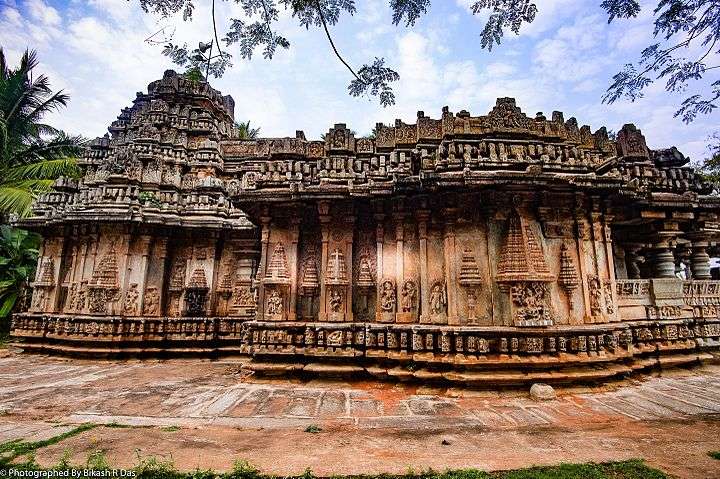Brahmeshvara Temple, Kikkeri
| Brahmeshvara Temple | |
|---|---|
| Hindu temple | |
|
The Brahmeshvara temple (1171 A.D.) at Kikkeri in Mandya district | |
| Country |
|
| State | Karnataka |
| District | Mandya District |
| Languages | |
| • Official | Kannada |
| Time zone | IST (UTC+5:30) |
The Brahmeshvara temple (also spelt Brahmeshwara) is a fine specimen of 12th century Hoysala architecture and is located in the town of Kikkeri of Mandya district in Karnataka state, India. It is only 10 km from the historically important town of Shravanabelagola (in Hassan district). The temple was built in 1171 AD by a wealthy lady called Bommare Nayakiti during the rule of Hoysala King Narasimha I.[1] This temple is a protected monument under the Karnataka state division of the Archaeological Survey of India.[2]
Architecture
_facing_shrine_door_at_Brahmeshvara_temple_in_Kikkeri.jpg)
The design of the temple is unique. the interior of the temple has been widened beyond its base by making the outer walls bulge out in a convex shape. This is a ekakuta (single shrine) construction. There is a four feet tall image of the Hindu god Shiva in one of the niches of the navaranga (hall). The madanika figures (also called salabhanjika, refers to the sculpture of a woman, displaying stylized feminine features) carved on the capitals of the pillars of the hall are works of fine art.[1]
The vimana (shrine that contains the cella) has a well executed, highly decorative and intact tower (shikhara).[3] The vestibule (called antechamber or antarala) which connects the cella to the hall has a sukhanasi (called "nose") which is actually a low protrusion of the tower over the shrine, built over the vestibule.[4] Other standard features in a Hoysala temple are the large domed roof over the tower, which is also the largest sculptural piece in a Hoysala temple (called the "helmet" or amalaka) and whose shape usually follows that of the shrine (square or star shape); the kalasa on top of it (the decorative water-pot at the apex of the dome); and the Hoysala crest (emblem of the Hoysala warrior stabbing a lion) over the sukhanasi.[5][6]
The temple's decorative features can be said to belong to the "old kind" prevalent even before the Hoysala times. In this type of decoration, below the superstructure (tower), an eaves that projects about half a meter runs all around the temple. Below the eaves are decorative miniature towers (the aedicula) on pilasters. The large wall images of deities and their attendants are placed below these decorative towers. Below these images is the base of the wall which comprises five different horizontal moldings, one of which is a row of blocks.[6][7]


Notes
- 1 2 "Mandya District Tourism". National Informatics Center, Mandya. Retrieved 2012-06-20.
- ↑ "Protected Monuments in Karnataka". Archaeological Survey of India, Government of India. Indira Gandhi National Center for the Arts. Retrieved 10 August 2012.
- ↑ Foekema (1996), p21, p27
- ↑ Foekema (1996), p22
- ↑ Foekema (1996), p27
- 1 2 Kamath (2001), p134
- ↑ Foekema (1996), p28
Gallery
_in_Brahmeshvara_Temple_at_Kikkeri.jpg) Dvarapalas (door keepers to the shrine) at Brahmeshvara temple at Kikkeri
Dvarapalas (door keepers to the shrine) at Brahmeshvara temple at Kikkeri Stellate layout of the shrine in Brahmeshvara temple at Kikkeri
Stellate layout of the shrine in Brahmeshvara temple at Kikkeri
- Relief art on outer wall of mantapa, miniature decorative towers on pilasters and Kirtimukha in Brahmeshvara temple at Kikkeri
_in_Brahmeshvara_Temple_at_Kikkeri%2C.jpg) Kirtimukha, or gargoyle faces in Brahmeshvara temple at Kikkeri
Kirtimukha, or gargoyle faces in Brahmeshvara temple at Kikkeri Close up of wall relief in Brahmeshvara temple at Kikkeri
Close up of wall relief in Brahmeshvara temple at Kikkeri
References
- Gerard Foekema, A Complete Guide to Hoysala Temples, Abhinav, 1996 ISBN 81-7017-345-0
- Kamath, Suryanath U. (2001) [1980]. A concise history of Karnataka: from pre-historic times to the present. Bangalore: Jupiter books. LCCN 80905179. OCLC 7796041.
- "Mandya District Tourism". National Informatics Center, Mandya. Retrieved 2012-06-20.
External links
| Wikimedia Commons has media related to Brahmeshvara Temple, Kikkeri. |